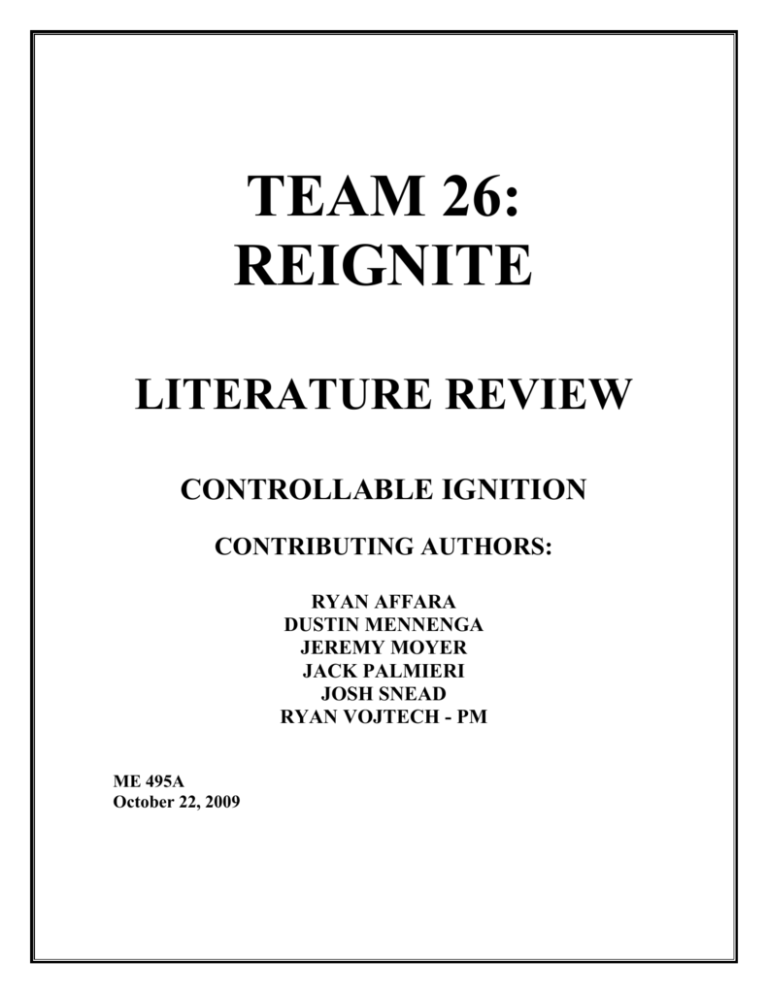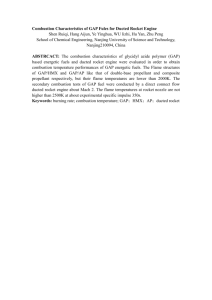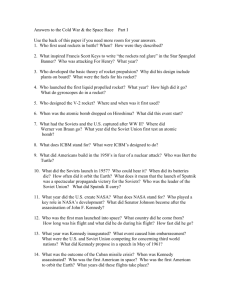
TEAM 26:
REIGNITE
LITERATURE REVIEW
CONTROLLABLE IGNITION
CONTRIBUTING AUTHORS:
RYAN AFFARA
DUSTIN MENNENGA
JEREMY MOYER
JACK PALMIERI
JOSH SNEAD
RYAN VOJTECH - PM
ME 495A
October 22, 2009
TABLE OF CONTENTS
INTRODUCTION (JM)...............................................................................3
EXISTING SYSTEMS (JP)………………………………………………..4
COMBUSTION (RV)………………………………………………………6
HEAT TRANSFER (RA)…………………………………………………..9
GAS SYSTEMS (JS)……………………………………………………...12
SAFETY (DM)…………………………………………………………….14
TESTS/MEASUREMENTS (JM)………………………………………..16
CONCLUSION (JM)……………………………………………………..19
REFERENCES……………………………………………………………20
2
INTRODUCTION
Hybrid rockets incorporate the use of a solid fuel and a liquid or gaseous oxidizer.
There are many benefits of the use of hybrid rockets. They are fairly inexpensive to
fabricate, exhibits minimal impact to the environment during operation, regulation of
thrust, and more importantly, reignition. This technology has been used in the past and is
continually looked at as an option for rockets today. Some of the major components of
study for hybrid rockets include the storage and flow of oxidizer, combustion of the solid
fuel and oxidizer, testing, measuring pressures, temperatures, and thrust, and the safety
measures that need to be taken during fabrication and testing. Research into these topics
has taken place in order to assist in the understanding of a hybrid rocket’s basic
components. This literature review has been assembled to demonstrate a basic
understanding of the workings of hybrid rockets and their history.
3
EXISTING HYBRID ROCKET SYSTEMS
While hybrid rocket reignition has not been around for a long time, there have
still been various companies who have been experimenting in this field for a while. And
those companies have made enough progress for our group to compare and contrast their
designs for our project. Many of the companies use similar designs and change the fuel
and oxidizers, if anything. So for this section, the different designs will be looked at
rather than the fuel combinations.
The Environmental Aeroscience Corporation (eAc) is a company that has been
designing and building hybrid rockets for over 20 years. They were responsible for the
first hybrid/ nitrous oxide rocket to be fired, the first hybrid rocket used by NASA, as
well as performing research for DARPA and the US Air Force [1]. The eAc has
developed many rocket designs but the Hyperion I and II rockets really utilized hybrid
rockets and reignition more than the others. The propulsion system for these rockets was
molded polymer fuel grain, and nitrous oxide was used as the oxidizer [2]. Once the eAc
had learned how to successfully use nitrous oxide in their rockets they focused on
reignition for the Hyperion II. The Hyperion II uses slightly different fuels than its older
brother, the Hyperion I; it has metalized solid fuel, and self-pressurizing nitrous oxide. In
preliminary testing, the eAc was able to fire the rocket for 10 seconds, turn it off for 15
seconds, and reignite it for 5 more seconds. All this was done without any external
reignition system, and the rocket utilized 98% of its fuel showing that reignition is not
necessarily a waste of fuel [3]. Shown below is a picture of the eAc testing one of the
Hyperion rockets.
4
The company Hypertek probably has one of the most user friendly hybrid rocket
system that is commercially available now. This is because it is a smaller design,
bringing the cost down, that is primarily made for testing at universities or other rocket
enthusiasts [4]. They sell various different versions of the rocket and also have all the
drawings and dimensions of the rocket on their website. The propulsion system for these
rockets uses thermoplastic fuel grains and nitrous oxide [5]. The Hypertek rockets use a
Kline valve which helps distribute the oxidizer uniformly and safely. Another aspect
which makes the Hypertek rocket great for universities and students is its safety features.
For one, the ignition system is completely pyrotechnic free, and the fuel and the oxidizer
are completely separated until ignition making the rocket much less volatile. Also, the
only thing a user has to do to the rocket to re-launch it is simply unscrew the spent fuel
grain and put a new one on [6]. Shown below is a 3-D rendering of a complete Hypertek
rocket system.
5
Having these different designs to use as a reference will help the team during the
design phase of the project; these options will allow us to determine the best application
for the team. Once the general design is chosen, we can start designing the smaller and
more detailed parts of the rocket based on the other research conducted by the team.
COMBUSTION
The combustion mechanism occurring in traditional hybrid rocket systems is that
of a diffusion flame which occurs due to the arrangement of the combustion chamber. A
diffusion flame is an artifact of the mixing process between the fuel and oxidizer which
occurs due to a diffusion process in the solid fuel. This diffusion flame is supported by
the gaseous oxidizer flowing over the solid fuel, which produces a velocity boundary
layer whose magnitude varies in relation the local Reynolds number [7]. Diffusion flames
6
are typically characterized by high soot production (due to the unmixed nature of the airfuel mixture), and a burn rate limited to the diffusion rate of the solid.
Diffusion in a solid [8] can be characterized by the following equation:
∂φ/∂t = D (∂2φ/∂x2)
Where; φ: concentration of solid (mol/m3)
t: time (s)
D: diffusion coefficient
x: length (m)
The characteristic flame can be characterized by the Reynolds number, which
describes the combustion flow as either laminar or turbulent, and accordingly evaluates
the mixing process. Laminar flow is initiated by molecular mixing, whereas in turbulent
flow mixing is enhanced by eddy currents [7]. The combustion flow process achieved in
a hybrid rocket motor is a function of many factors which include: combustion chamber
geometry, nozzle geometry, air-fuel flow rates, and the properties of the respective fuel
and oxidizers chosen. These methods, developed in conjunction with the ZeldovichNovozhilov solid-phase energy conservation method, provide a calculation strategy for
transient solid-propellant burning [9].
7
The diffusion rate of the solid fuel is a rate limiting function of the heat transfer
rate occurring at the interacting surface between the solid and gaseous components. In
dealing with hybrid combustion, methods have been devised which increase the heat
release rate by the addition of energetic ingredients such as aluminum (Al, Li , etc.) could
lead to an increase in the heat release at the fuel surface. This phenomenon occurs when
the aluminum particles are oxidized to aluminum oxide which stabilize the velocity
boundary layer and provide a more energetic interaction surface [10].
Common fuels utilized in hybrid rocket combustion include: Hydroxyl-terminated
polybutadiene (HTPB), butyl rubber, polyethylene, and paraffin [11] [12]. The regression
rate, and consequently the performance of the rocket is also a characteristic of the
specific fuel chosen to be used and must be considered in conjunction with the relevant
thermal properties.
Thermal Properties
Specific
Melting
Density
Point (K)
(kg/m3)
Thermal
α 106
Heat (cp),
conductivity (k),
(m2/s)
(J/kg K)
(W/mK)
Aluminum oxide
2323
3970
765
36
11.9
Paraffin
300
900
2890
0.24
-
Butyl Rubber (hard)
300
1190
-
0.16
-
Polyethylene
403
1400
1000
0.24
0.7
Table 1. Important Thermal properties of Fuels/Fuel Components [13]
8
HEAT TRANSFER: COMBUSTION CHAMBER
Heat generated by the solid fuel and oxidizer (N2O) is an important process of the
hybrid rocket. Inside the combustion chamber the reaction rate is so low at low
temperatures that the heat generated is lost to the surroundings but if the temperature of
the gas is raised high enough, the reaction rate becomes high enough that the heat
generated exceeds losses to the surroundings and the reaction takes off. If enough nitrous
oxide is used, the fuel gases liberated from the solid fuel grain will be completely
oxidized and the product gases will generally have temperatures over 5000º F [14].
Decomposition of nitrous oxide can be ignited at temperatures as low as 1202º F. The
thermal conductivity of N2O is 14.57 mW/(m.K) [15]. The thermal conductivity of C3H8
is 15.198 mW/(m.K) [16]. Below is a picture of the solid fuel inside the combustion
chamber and shows the heat transfer from the solid fuel to the oxidizer/fuel mixture [17].
Cylindrical systems often experience temperature gradients in the radial direction only
and may therefore be treated as one dimensional [13]. To estimate the amount of heat
transferred through the cylinder Fourier’s Law is applied.
9
Fourier’s Law
q= -k2πrLdT/dr
Where:
k=thermal conductivity
r=radius
L=length
T=temperature
This will not be a completely accurate assumption because it does not take into affect
heat generated inside the combustion chamber and other factors. Other values such as
temperature distribution and thermal resistance can be found by knowing the dimensions
of the cylindrical steel tube and temperatures at the surface. Thermal resistance can be
used to help find the heat transfer through the wall of the cylinder for safety reasons. The
equation is given by Rt=[ln(r2/r1)]/2πLk where r1 and r2 are the inner and outer radii of
the cylinder. Temperature distribution is useful in finding out temperatures at certain
points inside the cylinder. To determine the temperature distribution in the cylinder with
or without energy generation the equations are given as [13]:
10
Temperature Distribution without Energy
Temperature Distribution with Energy
Generation
Generation
T(r)=
T(r)= Ts+( q r22/2k) ln(r/r1)-( q /4k)(r2-r12)
(Ts,1 - Ts,2)
ln(r/r2)+Ts,2
ln(r1/r2)
r1=inner radius
k=thermal conductivity
r2=outer radius
r1=inner radius
Ts=surface temperature
r2=outer radius
q =energy generation
Ts=surface temperature
This pictures shows the temperature profiles when the fuel and oxidizer are near the solid
fuel grain [18].
11
GAS SYSTEMS
[20]
In the gas flow system two gases will be used to help ignite and oxidize the
combustion, propane (C3H8) and nitrous oxide (N2O). All our valves will be manually
controlled by switches. The gas flow system in our project will be very similar to the one
in the picture above except of using oxygen and nitrogen separately we will just use
nitrous oxide as our oxidizer. Knowing the characteristics of these gases such as pressure
and rate at which these gases are being added are very important for designing and for
making calculations. Pressure can be measured but to calculate a mass flow rate first the
velocity must be calculated by using the Bernoulli equation
12
where p = pressure, γ = specific weight of fluid, z = change in elevation, V = velocity,
and g = acceleration due to gravity [19]. Then the velocity can be used to find the mass
flow rate by the equation
where
= mass flow rate, ρ = density of fluid, A = cross-sectional area of the pipe, and
Q = volumetric flow rate [19]. Then the thrust of the engine can be compared to the mass
flow rate of the gases, or like in one previous experiment, the mass flux was calculated
and compared to the regression of the solid fuel [20].
Properties of these gases are important for both calculations and safety reasons, and some
properties are listed in the table below:
Propane (C3H8)
Nitrous Oxide (N2O)
Molecular weight : 44.096 g/mol [3]
Gas density (1.013 bar and 15 °C) : 1.91
kg/m3 [3]
Specific gravity (air= 1)(1.013 bar and 21
°C): 1.55 [3]
Ratio of specific heats (Gamma:Cp/Cv) (1
bar and 25 °C (77 °F)) : 1.134441 [3]
Molecular weight : 44.013 g/mol [4]
Gas density (1.013 bar and 15 °C) : 1.872
kg/m3 [4]
Specific gravity (air = 1) (1.013 bar and 21
°C (70 °F)) : 1.53 [4]
Ratio of specific heats (Gamma:Cp/Cv)
(1.013 bar and 15 °C (59 °F)) : 1.302256
[4]
Thermal conductivity (1.013 bar and 0 °C
Thermal conductivity (1.013 bar and 0 °C
(32 °F)) :15.198 mW/(m.K) [3]
(32 °F)) : 14.57 mW/(m.K) [4]
Table 2. Properties of Propane and Nitrous Oxide [15] [16]
13
By understanding the gas flow and some of the different properties of these gases, it will
help to understand what needs to be done in our project.
SAFETY
Hybrid rockets are known to be the safest rocket motors to construct. These
rockets are not as complex as liquid propellant engines, they are less expensive, and are
classified as having no TNT equivalent explosive power. However, there will always be
dangers when using propane and nitrous oxide. The largest hazard for a hybrid rocket
would be if a flame or even hot gasses were to flow back through the injector, making the
nitrous oxide ignite and causing a tank explosion. This is called a “blow back” and can be
caused during unstable combustion where the pressure drop is not sufficient. Other
hazards from a hybrid rocket include vessel ruptures from the hot combustion gases due
to an insulation failure or when too much nitrous oxide enters the combustion chamber
prior to ignition it can result in a temporary over pressure once ignited [21].
Propane will be used as the hybrid rocket’s fuel. This is an extremely flammable
liquefied gas. All known extinguishers can be used in case of a fire. In high
concentrations, if propane is inhaled, it can cause loss of mobility and consciousness, but
even in low concentrations, propane can cause dizziness, headache, nausea and loss of
co-ordination [22]. If these symptoms are present, remove the victim from the
contaminated area while wearing a breathing apparatus and keep the victim warm and
rested. Flush eyes with water for at least 15 minutes if the propane is spilled. Propane
should be kept in a suitable container away from oxidant gases below 50°C in a well
14
ventilated place. Propane is conventionally stored in standard pressure vessels at 140 psi
[23].
Nitrous oxide will be used as the hybrid rocket’s oxidizer. Nitrous oxide is labeled
as a non flammable, non toxic gas, but can be used as an oxidizing substance like in a
hybrid rocket. This liquefied gas strongly supports combustion and is able to react
violently with combustible materials [15]. Nitrous oxide can cause the same effects as
propane from inhalation and the same first aid measures should be taken. All known fire
extinguishers can be used on this oxidant. The boiling point of nitrous oxide is -88.5°C at
1 atm, and is normally maintained as a liquid at a pressure of 54 bar [21]. The main
hazard is when exposure to a fire could cause this container to explode. Combustion
products from a fire could produce hazardous fumes of nitric oxide/nitrogen dioxide
while the propane can produce the undetectable carbon monoxide.
Noise is a factor that may be overlooked when considering a hybrid rocket.
According to OSHA standards, in a general industry atmosphere the maximum impulse
noise allowed is 140 dB [24]. This is the decibel level when permanent hearing damage
begins and is equivalent to a gun muzzle blast or a jet engine from 100 feet away.
Eardrum rupture begins at 150 dB when the sound of a handgun shot at 1 foot away is
155 dB. A hybrid rocket is known to make hissing sounds but may be able to produce
hearing damage so proper ear protection should be worn when operating the rocket.
With all the hazards to a hybrid rocket, the hybrid rocket is still known as being
much safer than a liquid or solid fuel rocket since the fuel in a hybrid does not contain an
oxidizer making an explosion far less likely. The safety of a hybrid rocket is enhanced by
the control of the independently controlled oxidizer, which initiates the combustion
15
process. Stainless steel will be able to withstand any effects of corrosion and will be thick
enough to withstand the high temperature and high pressure of combustion. As long as
the rocket is well designed and carefully constructed, the hybrid will be very safe.
TESTS AND MEASUREMENTS
Testing is of major importance in any engineering design process. Static testing
of the designed hybrid rocket will need to be done in order to collect data. Data
acquisition during testing would include the measurements of thrust, gas and fluid flow,
temperatures, and pressures [25].
In other hybrid rocket tests, the thrust of the rocket was measured using a “strain
gauge load cell” mounted in front of the motor on the “test sled” [26]. Thrust power can
also be measured through the use of beam deflection. The rocket can be mounted on
vertical beams with known, uniform dimensions and material properties. When the
rocket is fired strain gauges on the beams could “convert strain to a voltage proportional
to the thrust force” [27]. The University of Arkansas at Little Rock used a bit more
sophisticated program to test the thrust of their hybrid rocket motors. The stand they use
is composed of “six uniaxial force elements” [28]. Uniaxial forces are measured and
using known distances between elements, moments can be calculated. A matrix can be
constructed relating distances between elements, resultant forces in the elements, forces
in the XYZ directions, and the moments around each axis. From this matrix, the thrust
value can be calculated [28].
16
Figure 1 FBD of Thrust Stand [28]
Figure 2 Moments and Thrust Matrix [28]
Another proposed method for measuring thrust is using a horizontal track and a spring. A
spring with known spring constant will be used. The length that the spring stretches
could be measured and used to measure the force applied to the spring (i.e. thrust). This
relationship can be expressed as F = -ks, where k is the spring constant and s is the length
of stretch [29]. Thrust can be plotted against oxidizer flow rate [27].
Pressure in the fuel chamber can be measured with a gauge mounted at the front
of the motor and the pressure of the oxidizer was measured between the oxidizer tank and
the oxidizer valve. Using thermocouples, the temperature of the rocket’s external casing
and the temperature of the flame exiting the nozzle can be measured for analysis. In
17
other cases, temperature measurements were also taken within the solid fuel to help
determine regression over the course of the testing [26]. The figure below shows the
possible placement of measurement devices [26]:
Figure 3 Test Measurements Setup [26]
18
CONCLUSION
The hybrid rocket concept is a very interesting idea that has been studied and used
for years. Their capability to be a safer and more efficient rocket makes them more
desirable than either solid or liquid propellant rockets. However, more studies need to be
done in order to fully utilize the potential of hybrid rockets. Concepts that have been
explored and discussed here include combustion and reignition, heat transfer within the
combustion chamber, gas flow of the oxidizer through the system, safety measures that
need to be taken, and methods for accurately testing the rocket. Past ideas will be
intertwined with new ideas in order to further explore the potential of hybrid rockets.
19
REFERENCES
[1] "EAc." Hybrid Rockets - eAc. Web. 17 Oct. 2009.
<http://www.hybrids.com/about.html>.
[2] "EAc." Hybrid Rockets - eAc. Web. 17 Oct. 2009.
<http://www.hybrids.com/hyperionI.html>.
[3] "EAc." Hybrid Rockets - eAc. Web. 17 Oct. 2009.
<http://www.hybrids.com/hyperion.html>.
[4] HyperTEK - The Easiest Access Of Them All. Web. 17 Oct. 2009.
<http://www.hypertekhybrids.com>.
[5] "!" HyperTEK - The Easiest Access Of Them All. Web. 17 Oct. 2009.
<http://www.hypertekhybrids.com/products.html>.
[6] "EAc." Hybrid Rockets - eAc. Web. 17 Oct. 2009.
<http://www.hybrids.com/hypertek.html>.
[7] Heywood, John B. Internal combustion engine fundamentals. New York: McGrawHill, 1988. Print.
[8] Callister, William D. Materials science and engineering an introduction. Hoboken,
NJ: John Wiley & Sons, 2006. Print.
[9] Geatrix, David R. "Transient Solid-Propellant Burning Rate Model." Proc. of
AIAA/ASME/SAE/ASEE Joint Propulsion Conference & Exhibit, Sacramento,
CA. 2006. Print.
[10] Bradford, Michael D., Roy J. Kniffen Jr., and Bevin C. McKinney. Hybrid rocket
combustion enhancement. Patent 5582001. Print.
[11] Rajan, Suri. "Solid Fuels." Telephone interview. 16 Oct. 2009.
[12] Strand, H.D., and R. Ray. "Hybrid Rocket Combustion Study." California Institute
of Technology. Web.
[13] Incropera, Frank P., David P. DeWitt, Theodore L. Bergman, and Adrienne S.
Lavine. Introduction to Heat Transfer. 5th ed. New York: Wiley, 2006. Print.
[14] Jacobson, Michael D. Multi-ignition controllable solid-propellant gas generator.
Patent 6250072. 26 June 2001. Print.
[15] "Nitrous oxide, N2O, Physical properties, safety, MSDS, enthalpy, material
compatibility, gas liquid equilibrium, density, viscosity, flammability, transport
properties." Physical properties of gases, safety, MSDS, enthalpy, material
compatibility, gas liquid equilibrium, density, viscosity, flammability, transport
properties. Web. 17 Oct. 2009.
<http://encyclopedia.airliquide.com/encyclopedia.asp?GasID=55>.
[16] "Propane, C3H8, Physical properties, safety, MSDS, enthalpy, material
compatibility, gas liquid equilibrium, density, viscosity, flammability, transport
properties." Physical properties of gases, safety, MSDS, enthalpy, material
compatibility, gas liquid equilibrium, density, viscosity, flammability, transport
20
properties. Web. 17 Oct. 2009.
<http://encyclopedia.airliquide.com/encyclopedia.asp?GasID=53>.
[17] "Hybrid Rocket Motor." Oct. 2006. Web. 13 Oct. 2009.
<http://www.tsinghua.edu.cn/docsn/lxx/mainpage/a/Web/index_files/Page349.ht
m>.
[18] "Hybrid Rocket Propulsion for Space Launch." Stanford Aero/Astro Department. 9
May 2008. Web. 20 Oct. 2009.
<http://aa.stanford.edu/aeroastro/50th/presentations/Karabeyoglu.pdf>.
[19] Crowe, Clayton T., Donald F. Elger, and John A. Roberson. Engineering Fluid
Mechanics. 8th ed. John Wiley & Sons, Inc., 2005. Print.
[20] Shanks, Robert, and M. Keith Hudson. "A Labscale Hybrid Rocket Motor for
Instrumentation Studies." Journal of Pyrotechnics 11 (2000). Web. 15 Oct. 2009.
<http://users.rowan.edu/~marchese/rockets05/paper1.pdf>.
[21] "Hybrid Rocket Science - www.ukrocketman.com." Ukrocketman.com - home. Web.
17 Oct. 2009. <http://www.ukrocketman.com/rocketry/hybridscience.shtml>.
[22] Physical properties of gases, safety, MSDS, enthalpy, material compatibility, gas
liquid equilibrium, density, viscosity, flammability, transport properties. Web. 17
Oct. 2009. <http://encyclopedia.airliquide.com/encyclopedia.asp>.
[23] "Propane@Everything2.com." Welcome to Everything@Everything2.com. Web. 17
Oct. 2009. <http://everything2.com/title/propane>.
[24] "Noise Levels." Quiet Solution. Web. 17 Oct. 2009.
<www.quietsolution.com/Noise_levels.pdf>.
[25] Sutton, George Paul. Rocket propulsion elements an introduction to the engineering
of rockets. New York: Wiley, 1986. Print.
[26] Eilers, Shannon D., and Stephen A. Whitmore. "Correlation of Hybrid Rocket
Propellant Regression Measurements with Enthalpy-Balance Model Predictions."
Journal of Spacecraft and Rockets 45.5 (2008): 1010-020. Print.
[27] Desrochers, Mary Fran, Gary W. Olsen, and M.K. Hudson. "Ground Test Rocket
Thrust Measurement System." Journal of Pyrotechnics 14 (2001): 50-55. Web. 17
Oct. 2009. <www.hybrid.ualr.edu>.
[28] Wright, Andrew B., Warfield Teague, Ann M. Wright, and Edmond W. Wilson.
"Instrumentation of UALR labscale hybrid rocket motor." Proc. of SPIE
6222.622202 (2006): 1-12. Print.
[29] Hibbeler, R. C. Statics and mechanics of materials. Upper Saddle River, N.J:
Pearson/Prentice Hall, 2004. Print.
21









